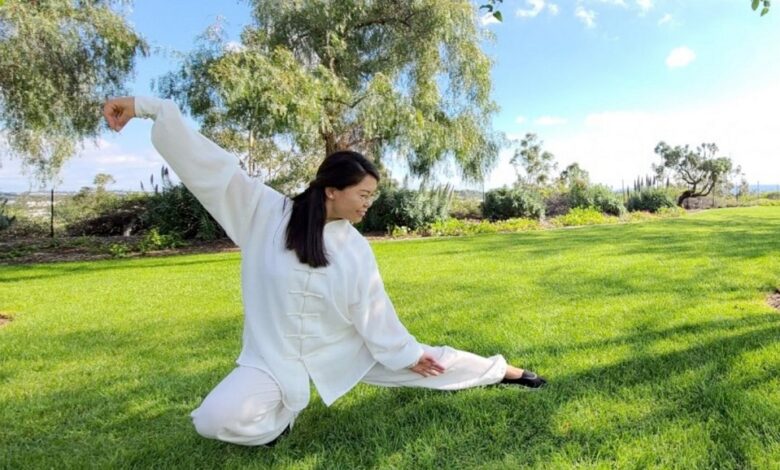
A new study shows that regular practice of tai chi movements, a form of exercise that evolved from Chinese martial art, can help lower high blood pressure, and can be more effective than regular aerobic exercise in regulating cardiovascular health.
Regular exercise has become an integral element in healthy lifestyles, and doctors are increasingly recommending exercise as an adjunct treatment — a therapy used in conjunction with standard treatments — for a wide variety of medical conditions. However, factors such as age, physical fitness or disabilities and personal choices can impact the amount, intensity and type of exercise that is achievable.
Tai chi is a mild, low-impact, slow-motion exercise that anyone, irrespective of their age or physical fitness, can easily incorporate into their lifestyle to achieve health benefits without the strain and risks associated with other strenuous exercises. The practice of tai chi involves a series of bodily motions without pausing, breathing deeply and naturally while focusing attention on your bodily sensations.
In general, tai chi improves a person’s functioning and quality of life by addressing the key components of fitness — muscle strength, flexibility, and balance, as well as to a lesser degree, their aerobic conditioning. Results from the new study on tai chi are likely to encourage more physicians to recommend this exercise as an adjunct therapy to lower elevated blood pressure in patients who are diagnosed with early stages of cardiovascular disease.
Doctors and healthcare professionals usually measure blood pressure to ascertain the cardiovascular health of their patients. The heart pumps blood all over the body through the rhythmic contraction and relaxation of heart muscles. The blood pressure measured during the contraction phase is referred to as systolic, and during the relaxation phase is termed diastolic. Too high or too low blood pressure increases the risk of cardiovascular conditions.
Blood pressure readings are divided into several categories. A blood pressure reading of less than 120 mmHg systolic and less than 80 mmHg diastolic is categorized as normal. An elevated reading is between 120-129 mmHg systolic and less than 80 mmHg diastolic. High blood pressure or hypertension stage one is between 130-139 mmHg systolic or 80-89 mmHg diastolic, while high blood pressure stage 2 is 140 mmHg or higher systolic or 90 mmHg or higher diastolic.
Hypotension is the opposite heart condition marked by abnormally low blood pressure, usually lower than 90 mmHg systolic or 60 mmHg diastolic. Hypotension decreases the flow of blood, which besides causing damage to the heart, brain, and other organs, can also lead to sudden dizziness or fainting that could result in falls, broken hips, or spine fractures, especially among aged people.
The study by researchers at the China Academy of Chinese Medical Sciences, compared the effects of tai chi and aerobic exercise on lowering blood pressure among participants with prehypertension — blood pressure which is slightly higher than normal. After twelve months of four one-hour tai chi or aerobic exercise sessions a week, the tai chi group experienced a more significant reduction in blood pressure readings.
The randomized clinical trial study included 342 adult participants with an average age of 50. All participants had prehypertension, which the researchers defined as 120 to 139 mmHg systolic and/or 80 to 89 mmHg diastolic. Participants who had certain conditions like diabetes, coronary heart disease, or chronic kidney disease were excluded from the study.
The researchers divided participants into two intervention groups. One group did tai chi, and the other participated in aerobic exercise. Each group participated in four one-hour supervised sessions a week of their activity for one year. The tai chi group did a 24-form Yang-style tai chi, and the aerobic exercise group did activities like jogging, cycling, and brisk walking.
The primary outcome that researchers measured was systolic blood pressure after twelve months. They also looked at several secondary outcomes, like changes in systolic blood pressure after six months, and average changes in diastolic blood pressure readings. Overall, the group participating in tai chi saw the most improvement in blood pressure readings.
After one year, the tai chi group saw an average decrease of 7.01 mmHg in systolic blood pressure. In contrast, the aerobic group saw an average decrease of 4.61 mmHg in systolic blood pressure. In addition, more participants in the tai chi group experienced blood pressure readings in a normal range after twelve months. The researchers also found that 24-hour ambulatory systolic blood pressure readings were lowered more in the tai chi group than in the aerobic group.
The results point to the potential benefits of tai chi in improving cardiovascular health. However, the researchers acknowledged that there were several limitations to their study, including that it was conducted in a single country, thereby limiting the diversity of participants. Moreover, the study did not evaluate the effects of tai chi on subgroups with prehypertension, and the number of participants were also relatively few, as over 17 percent of people who joined the study discontinued their participation midway.
They also noted that the results of their secondary outcomes were exploratory, and more research was needed to confirm those findings, in order to assess the long-term effects of tai chi on cardiovascular health. In addition, the study did not explore the mechanisms by which tai chi exerted its blood pressure-lowering effects. Gaining a better understanding of these mechanisms could provide valuable insights for future research and clinical practice.












